Gibilisco S. Everyday Math Demystified: A Self-Teaching Guide
Подождите немного. Документ загружается.

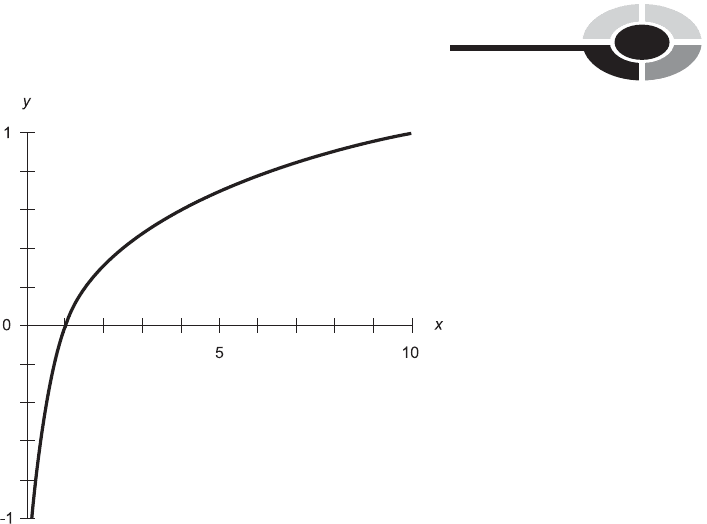
Figure 14-6 is an approximate graph of the function y ¼ log x. The domain
is limited to the positive real numbers. The range encompasses the entire
set of real numbers.
NATURAL LOGARITHMS
Base-e logarithms are also called natural logs or Napierian logs.In
equations, the natural-log function is usually denoted ‘‘ln’’ or ‘‘log
e
.’’ For
example:
ln 2:71828 ¼ log
e
2:71828 1:00000
Figure 14-7 is an approximate graph of the function y ¼ ln x. The domain
is limited to the positive real numbers, just as in the case of the common
log function. The range of the natural log function, also like the common
log function, encompasses the entire set of real numbers.
HOW DO WE FIND THEM?
Common and natural logarithms can be easily and quickly found using a
scientific calculator. That’s all you have to know for practical purposes.
Fig. 14-6. Approximate graph of the common logarithm function.
CHAPTER 14 Growth and Decay 351
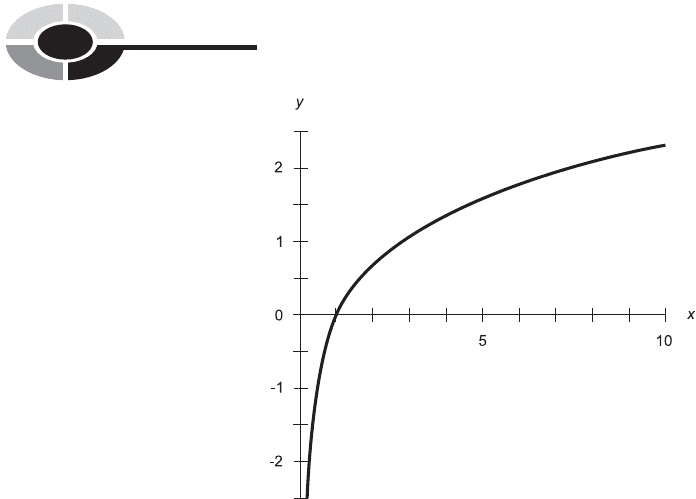
Once you have learned which keys to use (the instructions can help you with
this if it isn’t obvious), finding logarithms is painless.
Rules for Logarithms
Logarithmic functions, like their exponential-function counterparts, make it
possible to work with numbers in unique ways. And, as with exponentials,
logarithms have a way of coming up in work nowadays. Here are some
rules you should know about logarithmic functions.
LOGARITHM OF PRODUCT
If x and y are both positive real numbers, the common logarithm of the
product is equal to the sum of the common logarithms of the individual
numbers:
log xy ¼ log x þ log y
The natural logarithm of the product is equal to the sum of the natural
logarithms of the individual numbers:
ln xy ¼ ln x þ ln y
Fig. 14-7. Approximate graph of the natural logarithm function.
PART 4 Math in Science
352

LOGARITHM OF RATIO
Let x and y be positive real numbers. The common logarithm of their ratio,
or quotient, is equal to the difference between the common logarithms of
the individual numbers:
logðx=yÞ¼log x log y
The natural logarithm of their ratio, or quotient, is equal to the difference
between the natural logarithms of the individual numbers:
lnðx=yÞ¼ln x ln y
LOGARITHM OF QUANTITY RAISED TO A POWER
Let y be a real number, and let x be a positive real number. The common
logarithm of x raised to the power y can be expressed as a product:
log x
y
¼ y log x
The natural logarithm of x raised to the power y can be expressed as a
product:
ln x
y
¼ y ln x
LOGARITHM OF RECIPROCAL
Let x be a positive real number. The common logarithm of the reciprocal of x
is equal to the negative of the common logarithm of x, as follows:
logð1=xÞ¼log x
The natural logarithm of the reciprocal of x is equal to the negative of the
natural logarithm of x, as follows:
lnð1=xÞ¼ln x
LOGARITHM OF THE ROOT OF A QUANTITY
Let x be a positive real number. Let y be any real number except 0. The
common logarithm of the yth root of x (also denoted as x to the 1/y
power) is given by:
log x
ð1=yÞ
¼ðlog xÞ=y
CHAPTER 14 Growth and Decay 353

The natural logarithm of the yth root of x (also denoted as x to the 1/yth
power) is given by:
ln x
ð1=yÞ
¼ðln xÞ=y
PERCEIVED INTENSITY
If you have ever done serious work with high-fidelity (hi-fi) equipment,
you’ve heard about units called decibels, symbolized dB. The decibel is a
logarithmic unit. It is used to express the relative intensity of sound waves,
radio signals, and even visible light.
The concept of the decibel evolved because our senses perceive variable
effects according to the logarithm of the intensity, not in direct proportion to
the intensity. This is a defense mechanism against the harshness of the world.
If we perceived phenomena such as sound and light in direct proportion
to their true levels, the variability would be overwhelming. We might not be
able to hear someone whispering a meter away, yet a trumpet blast from
across a room would knock us out. We might not be able to see the full moon
on a clear night, but we would be blinded by the light of a cloudy day.
Imagine two sounds having the same frequency and wave shape, such as
middle C played on a trombone. Call them ‘‘sound number 1’’ and ‘‘sound
number 2.’’ Imagine that a trombone plays note 1, pauses for a moment, and
then plays note 2. Notes 1 and 2 differ in intensity by 1 dB if the change is just
barely enough so that a listener can tell the difference when the change is
expected. This turns out to be a difference in audio power of approximately
26%, or a ratio of 1.26:1. If the change is not expected, the smallest
detectable audio power difference is about 100%, or a ratio of 2:1 (believe it
or not).
If P
1
is the power (in watts) contained in sound 1 and P
2
is the power
(also in watts) contained in sound 2, their relationship in decibels, R, is given
by this formula:
R ¼ 10 logðP
2
=P
1
Þ
This formula also works for radio-signal power and light-brilliance power.
If we know the relationship R in decibels between phenomenon number 1
and phenomenon number 2, then the actual power ratio P
2
/P
1
is a common
exponential function of R, as follows:
P
2
=P
1
¼ 10
ðR=10Þ
PART 4 Math in Science
354

PROBLEM 14-11
Suppose two sounds differ in volume by a power ratio of 2:1, which allegedly
is the smallest difference a listener can detect if the change is not anticipated.
What is the ratio in decibels?
SOLUTION 14-11
Use the formula above. Let P
2
¼ 2 and P
1
¼ 1. Then:
R ¼ 10 logðP
2
=P
1
Þ
¼ 10 logð2=1Þ
¼ 10 log 2
¼ 10 0:30103
¼ 3:0103 dB
We can round this off to 3 dB.
PROBLEM 14-12
Suppose you are listening to a musical recording and the needles on your hi-fi
amplifier are peaking at a reading of 0 dB. You boost the volume until the
needles kick up to þ10 dB. By what factor have you increased the audio
power level?
SOLUTION 14-12
In the formula, set R ¼ 10 because the change in sound volume is þ10 dB.
From this, calculate the audio power ratio:
P
2
=P
1
¼ 10
ðR=10Þ
¼ 10
ð10=10Þ
¼ 10
1
¼ 10
This means you have increased the audio power by a factor of 10:1.
Graphs Based on Logarithms
Logarithms make it possible to graph certain functions that don’t lend them-
selves to clear portrayal on the rectangular (Cartesian) coordinate plane.
This is done by making the increments on one or both axes proportional
to the logarithm of the variable value, rather than directly proportional to
CHAPTER 14 Growth and Decay 355
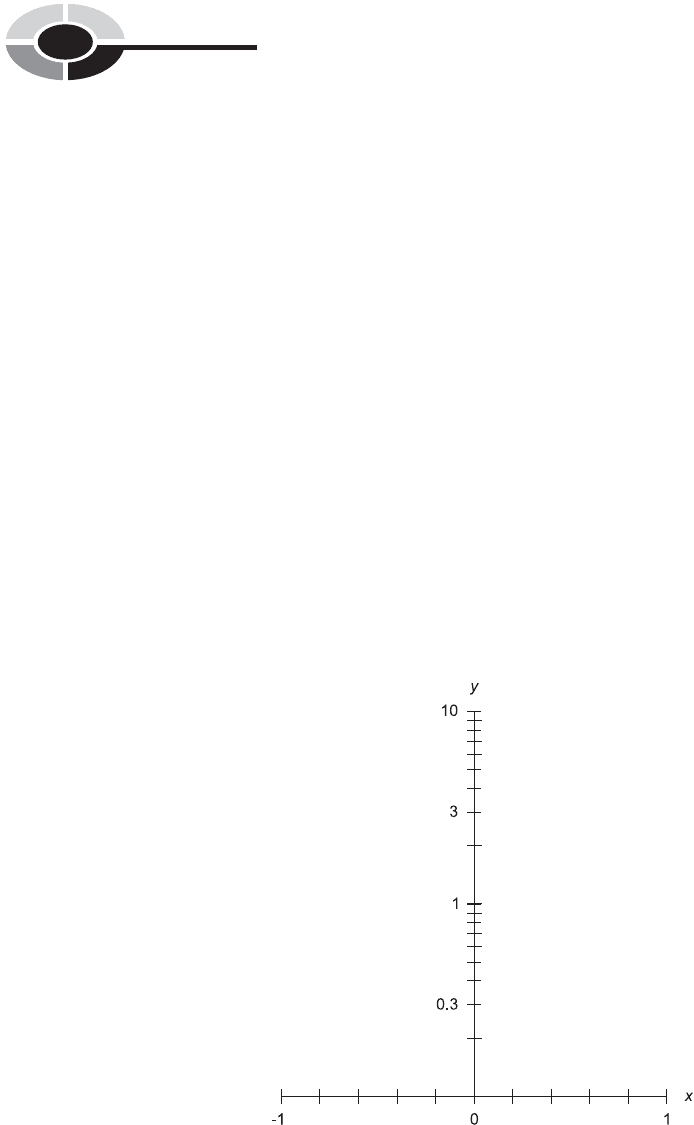
the variable value. A scale or axis in which the sizes of the increments are
in direct proportion to the variable value is called a linear scale or a linear
axis. A scale or axis in which the sizes of the increments are in proportion
to the logarithm of the variable value is called a logarithmic scale or a
logarithmic axis.
SEMILOG (x-LINEAR) COORDINATES
Figure 14-8 shows semilogarithmic (semilog) coordinates for defining points in
a portion of the xy-plane. The independent-variable (x) axis is linear, and the
dependent-variable ( y) axis is logarithmic. In this example, functions can be
plotted with domains and ranges as follows:
1 x 1
0:1 y 10
The y axis in Fig. 14-8 spans two orders of magnitude (powers of 10).
The span could be larger or smaller than this, but in any case the y values
cannot extend all the way down to 0. This is because the logarithm of 0 is
undefined.
Fig. 14-8. Semilog xy-plane with linear x axis and logarithmic y axis.
PART 4 Math in Science
356
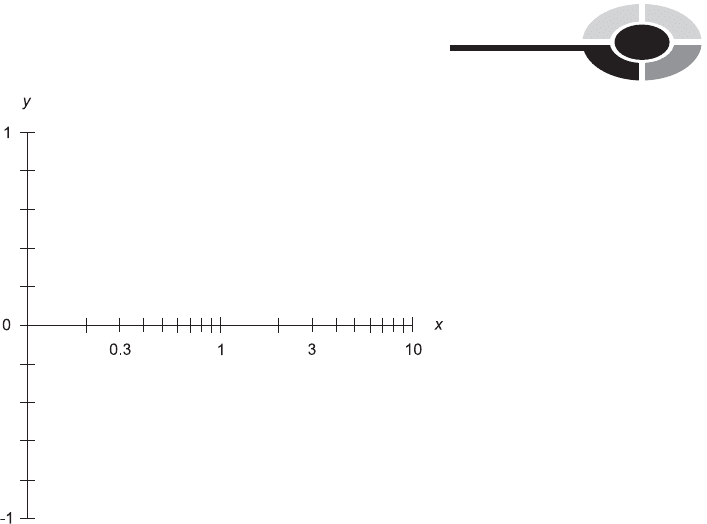
SEMILOG ( y-LINEAR) COORDINATES
Figure 14-9 shows a different sort of semilog coordinate system for defining
points in a portion of the xy-plane. Here, the independent-variable ( x) axis
is logarithmic, and the dependent-variable ( y) axis is linear. In this example,
functions can be plotted with domains and ranges as follows:
0:1 x 10
1 y 1
The x axis in Fig. 14-9 spans two orders of magnitude. The span could be
larger or smaller, but in any case the x values cannot extend all the way
down to 0.
LOG–LOG COORDINATES
Figure 14-10 shows log–log coordinates for defining points in a portion of
the xy-plane. Both axes are logarithmic. In this example, functions can be
plotted with domains and ranges as follows:
0:1 x 10
0:1 y 10
Fig. 14-9. Semilog xy-plane with logarithmic x axis and linear y axis.
CHAPTER 14 Growth and Decay 357
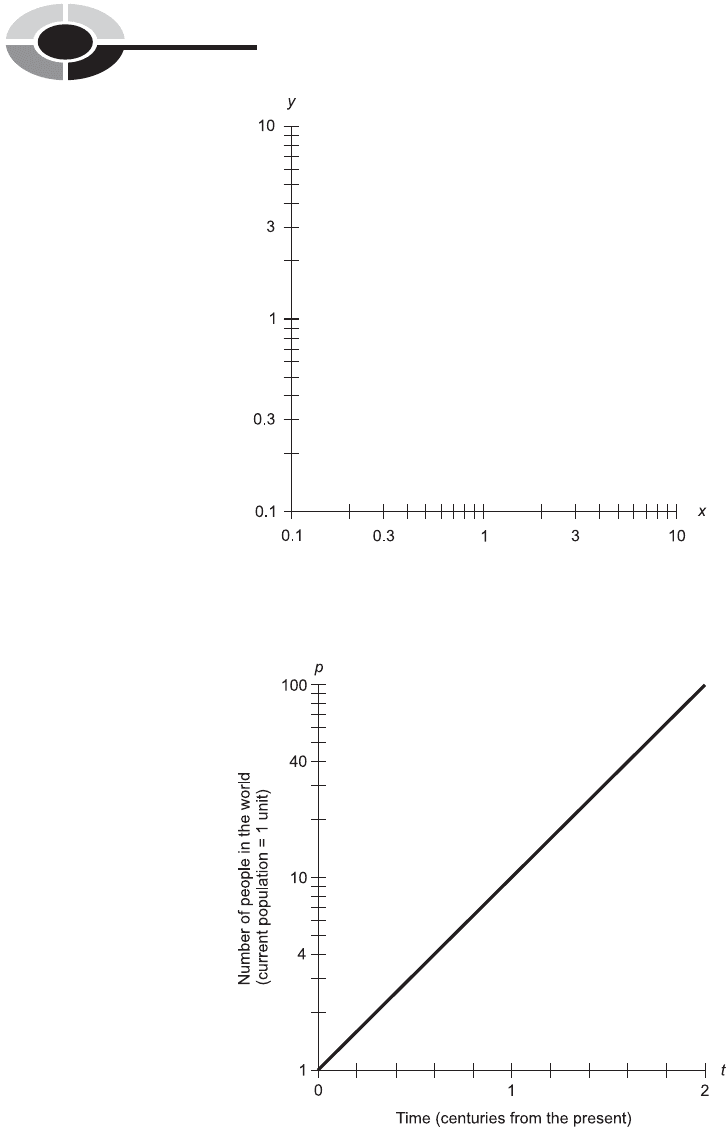
Fig. 14-10. Log–log xy-plane. Both axes are logarithmic.
Fig. 14-11. Illustration for Problem 14-13.
PART 4 Math in Science
358

The axes in Fig. 14-10 span two orders of magnitude. The span of either axis
could be larger or smaller, but in any case the values cannot extend all the
way down to 0.
PROBLEM 14-13
In semilog coordinates, graph the world population p, in population units,
as a function of time t, in centuries, according to the theory of Professor P.
Show the function over the domain from t ¼ 0 (right now) to t ¼ 2(2
centuries, or 200 years, from now). Use a linear scale for the horizontal
axis and a logarithmic scale for the vertical axis.
SOLUTION 14-13
Refer to Fig. 14-11. Note that the graph is a straight line. One of the
major assets of semilogarithmic coordinates is the fact that they can
show exponential and logarithmic functions as straight lines, rather than as
curves.
Quiz
Refer to the text in this chapter if necessary. A good score is eight correct.
Answers are in the back of the book.
1. Imagine a frog that jumps halfway to a wall. After 10 seconds, it
jumps halfway to the wall again. After another 10 seconds, it jumps
halfway to the wall once again. It keeps repeating this process. In
theory, how long will it take to reach the wall after its first jump?
(a) More information is needed to answer this question.
(b) 10
2
, or 100, seconds.
(c) 2
10
, or 1024, seconds.
(d) It will never reach the wall.
2. Imagine a frog that jumps halfway to a wall. After 4 seconds, it jumps
halfway to the wall again. After 2 seconds, it jumps halfway to the
wall again. After 1 second, it jumps halfway to the wall again. The
frog keeps repeating this process, but the intervals between jumps
keep getting half as long: 1/2 second, then 1/4 second, and so on.
In theory, how long will it take to reach the wall, if we start timing
it the moment it finishes its first jump?
(a) More information is needed to answer this question.
(b) 8 seconds.
CHAPTER 14 Growth and Decay 359

(c) 4
2
, or 16, seconds.
(d) 2
8
, or 256, seconds.
3. Consider this sum of numbers:
S ¼ 4 4 þ 4 4 þ 4 4 þ 4 4 þ :::
Which of the following statements is true?
(a) S is a convergent series.
(b) S is an arithmetic series.
(c) S is an infinite series.
(d) S is not a series.
4. What is the base-10 logarithm of 0.00001?
(a) e/10
(b) e/10
(c) 5
(d) 5
5. Which of the following points cannot, in theory, be shown on a
log–log (x,y) coordinate system?
(a) The point corresponding to x ¼ 1 and y ¼ 1.
(b) The point corresponding to x ¼ 0 and y ¼ 1.
(c) The point corresponding to x ¼ 10 and y ¼ 10.
(d) The point corresponding to x ¼ 0.1 and y ¼ 0.1.
6. What is the natural logarithm of e?
(a) 0
(b) 1
(c) e
(d) 1/e
7. Suppose a sequence of numbers is such that each value is exactly 4 less
than the value before it. This is an example of
(a) a geometric progression
(b) an arithmetic progression
(c) a logarithmic progression
(d) a fractional progression
8. Suppose you’re listening to a compact disc on your new high-powered
stereo sound system. The VU (volume unit) meter needles are kicking
up to the points marked 0 dB, exactly where the black lines end
and the red lines begin. If you increase the gain so the needles are
kicking up to þ6 dB in the red zone, the sound power coming from
PART 4 Math in Science
360
